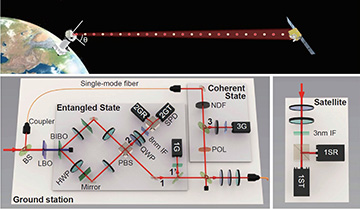A diagram of the optical layouts of the ground station and the Micius satellite, which together were used to look for a potential flaw in standard quantum theory. [Image: University of Science and Technology of China][Enlarge image]
For decades, physicists have been trying to develop a full-fledged theory of quantum gravity that preserves quantum mechanics while modifying Einstein’s general theory of relativity. So far, they have been unsuccessful. What’s more, there are precious few data that can put such theories to the test.
Now, a team of researchers in China has carried out a satellite-based experiment that goes some way toward ruling out an alternative kind of theory—one that assumes it is quantum mechanics, rather than relativity, which needs an overhaul (Science, DOI: 10.1126/science.aay5820.)
Testing event formalism
The theory in question, known as event formalism, extends standard quantum theory so that it can describe exotic regions of space-time known as closed time-like curves—which, if they existed, would take an object back to a point in space and time that it had already passed through. One consequence of this nonlinear theory is gravitational decoherence—the destruction of entanglement between quantum particles when those particles travel through different gravitational potentials.
To look for evidence of this effect, a group led by OSA Fellow Jian-Wei Pan of the University of Science and Technology of China in Shanghai exploited the gravitational gradient experienced by any object moving away from the surface of the Earth.
The researchers generated and then split a series of entangled pairs of photons at a ground station in Tibet, before detecting one half of each pair on the ground and sending the other to a satellite known as Micius. Launched into a 500-km-high sun-synchronous orbit by the Chinese Academy of Sciences in 2016, Micius has also been used to perform tests of entanglement, cryptography and teleportation.
The researchers were looking for one particular signature of gravitational decoherence—a randomizing of the arrival times of photons at the satellite compared with those on the ground, which is not predicted by standard quantum theory. To measure this subtle effect, they had to account for other processes that could disrupt the correlation between the two sets of photons, such as absorption and scattering in the atmosphere and limited detector efficiency.
Multiple orbits, no surprises
Performing measurements over the course of a handful of orbits, Pan and his colleagues found that the data collected onboard the satellite and on the ground contained no surprises. “Our measurement results are consistent with the standard quantum theory,” the researchers wrote in their paper, “and hence do not support the prediction of event formalism.”
Team-member Timothy Ralph of the University of Queensland in Australia, who with colleagues Gerard Milburn and Tony Downes put forward the theory of event formalism tested in the latest work, says that the result is an important step forward in trying to establish experimentally whether general relativity or quantum mechanics is at fault.
“Whilst this does not disprove all theories of this kind, it does for the first time start the process of accumulating experimental evidence for one or other approach,” Ralph said. “It is thus a significant advance.”
Next steps and new satellites
In making these measurements, Pan and his team outflanked a group of researchers that had drawn up a proposal for the European Space Agency to carry out a similar test using photons fired to the International Space Station. But the China-led group doesn’t intend to stop there. It plans on carrying out a more sensitive version of the experiment in order to rule out an even weaker gravitational decoherence, which has been predicted by a variation of the current theory.
This would involve launching a new satellite—in around 2024—to a higher orbit and operating it over a longer period, as well as perhaps improving the experiment’s temporal resolution so that it is comparable with the time over which photons remain in a coherent quantum state.

